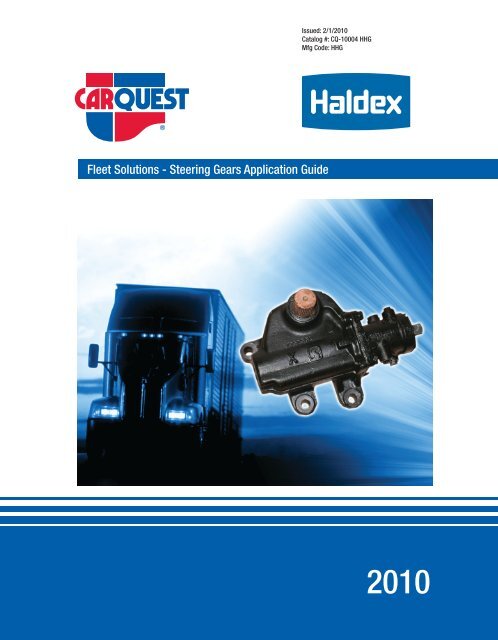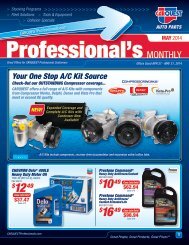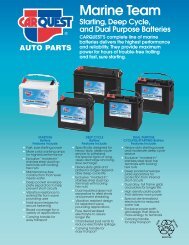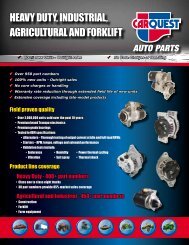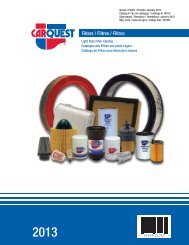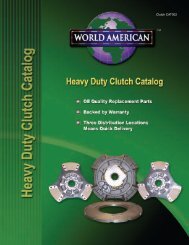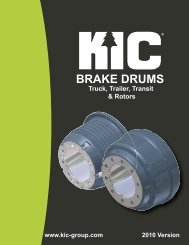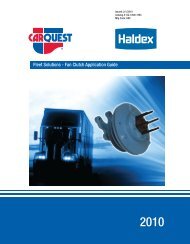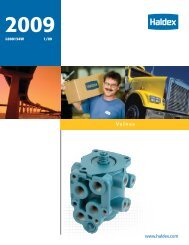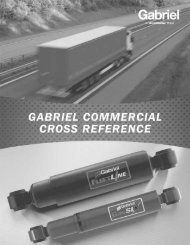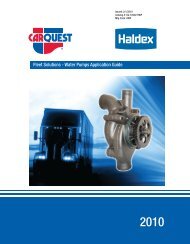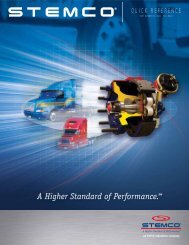Steering Gears Application Guide - CARQUEST Auto Parts
Steering Gears Application Guide - CARQUEST Auto Parts
Steering Gears Application Guide - CARQUEST Auto Parts
- No tags were found...
Create successful ePaper yourself
Turn your PDF publications into a flip-book with our unique Google optimized e-Paper software.
Issued: 2/1/2010Catalog #: CQ-10004 HHGMfg Code: HHGFleet Solutions - <strong>Steering</strong> <strong>Gears</strong> <strong>Application</strong> <strong>Guide</strong>2010 2009
16−POWER STEERING GEARSForewordPURPOSE OF THIS SECTIONThis section is designed as a reference for Haldex Commercial Vehicle Systems new and remanufactured air brake systemcomponents and accessories, sold under the Haldex and Midland product names. Products described include all pertinentinformation needed to replace an OEM installed component or to help design an original installation. If there is a servicenumber for a given part, it is noted in the product number table.DESIGN FLEXIBILITYThe products presented in this section are described by function and usage. Technical data and mounting configurationsare also provided. Throughout this section, reference is made to numerous specific OEM applications. This section is not,however, intended to be a mutually exclusive listing of all part numbers and designs available. Should the need for a designnot presented occur, contact your Haldex Commercial Vehicle Systems sales representative for additional information.WARRANTY INFORMATIONProper service and repair are important to the safe, reliable operation of any motor vehicle. To prevent personal injuryand/or vehicle damage, careful and cautious service procedures recommended by the vehicle manufacturer should befollowed by anyone servicing a motor vehicle. For details on warranty of Haldex Commercial Vehicle air brake systemcomponents and accessories, refer to L20221 Aftermarket Warranty Policy. For warranty returns, use L90005 WarrantyAdjustment Form. To obtain further information, visit the www.haldex.com website, select North America/English in dropdown box then search for Warranty.ORDERING PROCEDUREMost customers can place electronic orders on the www.haldex.com website by obtaining a username and password or byusing EDI. For additional information about electronic orders or to place an order by phone or fax, contact CustomerService in U.S. or Canada at numbers listed below:U.S. Customer Service:Canada Customer Service:Phone: 800−643−2374 Phone: 800−267−9247Fax: 800−533−1941 Fax: 519−621−3924Mail: Commercial Vehicle SystemsHaldex Brake Products CorporationAttn: Customer Service Department10930 N. Pomona Ave.Kansas City, MO 64153Mail:Commercial Vehicle SystemsHaldex LimitedCanadian Distribution CentreAttn: Customer Service Department500 Pinebush Road, Unit 1Cambridge, Ontario N1T 0A5IMPORTANT NOTICEThe data listed herein is correct to the best of Commercial Vehicle Systems knowledge and belief, having been compiledfrom reliable and official sources of information. However, COMMERCIAL VEHICLE SYSTEMS CANNOT ASSUME ANYRESPONSIBILITY for possible error or misapplication of the product. Final determination of the suitability of the productsfor the use contemplated by the Buyer is the sole responsibility of the Buyer. Commercial Vehicle Systems shall have noresponsibility in connection with this suitability. It is not our intention to imply that any of the components in this catalog inconnection with an engine make or model are made by any engine manufacturer.Copyright 2010Commercial Vehicle SystemsHaldex Brake Products Corporation10930 N. Pomona Ave.Kansas City, MO 64153All rights reserved.Materials may only be reproduced with written permission of Commercial Vehicle Systems.16 − 4
Warranty Information16−POWER STEERING GEARSHeavy duty power steering gears have a twelve (12) month, 3,600 hour (whichever comes first) warranty. For furtherdetails, refer to L20221 Aftermarket Warranty Policy. For warranty return, use L90005 Warranty Adjustment Form.SPECIAL NOTEProper service and repair is important to the safe reliable operation of all motor vehicles. Careful and cautiousservice procedures recommended by the manufacturers should be taken by anyone servicing a motor vehicle tominimize the risk of personal injury and vehicle damage. All information, illustrations, specifications andschematics contained in this section are based on the latest information available at the time of publication. Theright is reserved to make changes at any time without notice.WARNING FOR PROPER STEERING GEAR OPERATION1. Do not weld, braze or solder any steering gear or system arm components.2. Maximum flow under any conditions must not exceed vehicle manufacturers specifications.3. Always inspect any steering component(s) which has been (or is suspected to have been) subject toimpact. Replace any part that has been damaged or is questionable.4. Never mix or use improper oils for units.STEERING SYSTEM MAINTENANCE TIPS1. Prevent internal bottoming of the steering gear. Carefully check axle stops to be sure that they meet themanufacturer's specifications.2. Regularly check the fluid and the fluid level in the power steering reservoir.3. Keep tires inflated to correct pressure.4. Always use a puller, never a hammer or torch, to remove pitman arms.5. Investigate and immediately correct the cause of any play, rattle, or shimmy in any part of the steeringlinkage or steering mechanism.6. Remove the cause of steering column misalignment.7. Encourage all drivers to report any malfunctions or accidents that could have damaged steeringcomponents.8. Do not attempt to weld any broken steering component. Replace the component with original equipmentonly.9. Do not cold straighten, hot straighten, or bend any steering system component.10. Always clean off around the reservoir filler cap before you remove it. Prevent dirt or other foreign matterfrom entering the hydraulic systems.11. Investigate and correct any external leaks, no matter how minor.12. Replace filters and pumps in compliance with specification.13. If extended stationary use of vehicle is developing excessive hydraulic fluid temperatures, consultvehicle manufacturer for auxiliary cooling method.14. Maintain grease pack applied behind the input and output shaft's protector seal as a general maintenanceprocedure.16 − 5
16−POWER STEERING GEARSLight DutyLight Duty <strong>Steering</strong> <strong>Gears</strong> − RemanufacturedSpecifications:Approximate Weight30 lbs.SKU# Product Description Stamped # Casting # Year Type CoreGroupRG1416XRemanufactured Light Duty <strong>Steering</strong>GearSPA DX D9AC−AA 1980−1995 Ford F100−F350Truck2WD & 4WDSG1101RG1456XRemanufactured Light Duty <strong>Steering</strong>GearSPA HY 3550 1997−2000 Ford F100−F350Truck2WD & 4WDSG110116 − 6
Bendix®16−POWER STEERING GEARSBendix® <strong>Steering</strong> Gear KitSKU# Product Description MFG. #RG300K <strong>Steering</strong> Gear Kit for Bendix® Model 300 C300N−SKRP500K <strong>Steering</strong> Gear Kit for Bendix® Model 500 C500N−SK16 − 7
16−POWER STEERING GEARSBendix®Bendix® <strong>Steering</strong> <strong>Gears</strong> − RemanufacturedSKU#RG22603XRG22682XProductDescriptionRemanufacturedBendix® Model300 <strong>Steering</strong>GearRemanufacturedBendix® Model500 <strong>Steering</strong>GearApprox.WeightMFG. #Casting#HosesMountingBoltsSectorShaftInputSplineOEM #CoreGroup60 lbs. 2260377 2260377 2 3 Clamp Flat E8HT3N503AD SG900094 lbs. 2268244 2260351 2 3 Clamp Flat 2268244 SG900016 − 8
Ross16−POWER STEERING GEARSRoss <strong>Steering</strong> <strong>Gears</strong> − RemanufacturedSKU# Product Description Approximate Weight Manufacture Number Core GroupRG50302X Remanufactured Ross Manual <strong>Steering</strong> Gear 40 lbs. 503AS144 SG8001RG50303X Remanufactured Ross Manual <strong>Steering</strong> Gear 40 lbs. 503AS074 SG8001RG50304X Remanufactured Ross Manual <strong>Steering</strong> Gear 40 lbs. 503AS110 SG8001RG50306X Remanufactured Ross Manual <strong>Steering</strong> Gear 40 lbs. 503AS124 SG800116 − 9
16−POWER STEERING GEARSSaginawSaginaw <strong>Steering</strong> <strong>Gears</strong> − RemanufacturedFeatures:• RG78131X − Dual Piston Gear, Metric, GMC−Chev. <strong>Application</strong>• RG78132X − Dual Piston Gear, GMC−Chev. <strong>Application</strong>• RG78133X − Dual Piston Gear, Metric, GM Topkick <strong>Application</strong>• RG78303X − Dual Piston Gear, S−Line Internationals.Specifications:Astro KitBrigadier KitDual KitRG78001RG78002RG78003Notes:1) RG78020X not picturedSKU# Product Description Approx.WeightMFG. # Casting # Core GroupRG56906X Reman. Saginaw <strong>Steering</strong> Gear 38 lbs. 5696067LV 5696067 SG6001RG56907X Reman. Saginaw <strong>Steering</strong> Gear 55 lbs. 5696067HV 5696067 SG6001RG56908X Reman. Saginaw <strong>Steering</strong> Gear 34 lbs. 5690653 5690653 SG6001RG78020X Reman. Saginaw <strong>Steering</strong> Gear 55 lbs. 7802018 7802018 SG6001RG78131D9XRG78131XReman. Saginaw <strong>Steering</strong> Gear − Dual PistonGear, MetricReman. Saginaw <strong>Steering</strong> Gear − Dual PistonGear, Metric55 lbs. 781316M 7813161Metric52 lbs. 781316M 7813161MetricSG6001SG6001RG78132X Reman. Saginaw <strong>Steering</strong> Gear − Dual Piston Gear 54 lbs. 781316MN 7813161 SG6001RG78133XReman. Saginaw <strong>Steering</strong> Gear − Dual Piston Gear− Metric60 lbs. 26002502 − SG6004RG78303X Reman. Saginaw <strong>Steering</strong> Gear − Dual Piston Gear 57 lbs. 78303891 7830389 SG6001RG78323X Reman. Saginaw <strong>Steering</strong> Gear 37 lbs. 7832331 7832331 SG600116 − 10
Saginaw16−POWER STEERING GEARSSaginaw Cylinders − RemanufacturedFeatures:• Need weld to weld measurement to order correct cylinder.SKU# Product Description <strong>Application</strong> Length Core GroupRG40011XRemanufactured SaginawCylinderMost GMC−Chevrolet trucks with rotary valve Saginawgears.11" SC1001RG40113XRemanufactured SaginawCylinderMost GMC−Chevrolet trucks with rotary valve Saginawgears.13" SC100116 − 11
16−POWER STEERING GEARSSaginawSaginaw Service KitsSKU# Product Description Picture NumberRG78001 Astro Service Kit for Saginaw Power <strong>Steering</strong> Gear −RG78002 Brigadier Service Kit for Saginaw Power <strong>Steering</strong> Gear 1RG78003 Dual Service Kit for Saginaw Power <strong>Steering</strong> Gear 2RG8295K 710ML Seal Kit for Saginaw Power <strong>Steering</strong> Gear −16 − 12
Sheppard16−POWER STEERING GEARS292 Series <strong>Steering</strong> <strong>Gears</strong> − RemanufacturedSpecifications:Shaft Diameter 2"Seal KitRG29210Approximate Weight 85 lbs.SKU# Product Description Approx.WeightRG29202XRG29203XRG29204XRG29205XRG29207XRG29208XRG29209XRemanufactured Sheppard 292 Series<strong>Steering</strong> GearRemanufactured Sheppard 292 Series<strong>Steering</strong> GearRemanufactured Sheppard 292 Series<strong>Steering</strong> GearRemanufactured Sheppard 292 Series<strong>Steering</strong> GearRemanufactured Sheppard 292 Series<strong>Steering</strong> GearRemanufactured Sheppard 292 Series<strong>Steering</strong> GearRemanufactured Sheppard 292 Series<strong>Steering</strong> GearMFG. # Casting # OEM # CoreGroup80 lbs. 292RR2 292S−4S5 443675C92 SG700188 lbs. 292BYL4 292 585922C91 SG700189 lbs. 292AJL4 292S−4S−5 585922C91 SG700187 lbs. 292SCA5 292S−4S6 573063C91 SG700190 lbs. 292SCX6 292 S−6 15554382 SG700184 lbs. 292SCA6 292 S−6 1650926C91 SG700184 lbs. 292SBE5 292 594565C91 SG700116 − 13
16−POWER STEERING GEARSSheppard392 Series <strong>Steering</strong> <strong>Gears</strong> − RemanufacturedSpecifications:Shaft Diameter 2"Approximate Weight 100 lbs.Seal KitRG39210SKU# Product Description MFG. # Casting # OEM # Core GroupRG39201X Reman. Sheppard 392 Series 392BR5 392 464027C92 SG7003RG39202X Reman. Sheppard 392 Series 392SCH4 392S−4S−6 584547C91 SG7003RG39203X Reman. Sheppard 392 Series 392SU4 392S−4S6 492982C92 SG7003RG39204X Reman. Sheppard 392 Series 392SCU4 392S 585920C91 SG7003RG39205X Reman. Sheppard 392 Series 392SBV4 392 S4 20QC493088P2 SG7003RG39206X Reman. Sheppard 392 Series 392SGA6 392S−6 14−10064 SG7003RG39207X Reman. Sheppard 392 Series 392SFY6 392S−6 14−10065 SG7003RG39208X Reman. Sheppard 392 Series 392SFZ6 392S−6 15517614J SG7003RG39209X Reman. Sheppard 392 Series 392SFV4 392S−4S6 1649465C91 SG7003RG39211X Reman. Sheppard 392 Series 392BSL5 392 S4 464028C93 SG7003RG39214X Reman. Sheppard 392 Series 392SGM6 392S−4S6 14−10201 SG7003RG39215X Reman. Sheppard 392 Series 392CG5 392S−5 K254−201 SG7003RG39216X Reman. Sheppard 392 Series 392SDX6 392S−6 10−02084 SG7003RG39217X Reman. Sheppard 392 Series 392SGS4 392S4−5−6 1649466C91 SG7003RG39218X Reman. Sheppard 392 Series 392SHA4 392S−4S−6 1650932C91 SG7003RG39220X Reman. Sheppard 392 Series 392S5 392S−5 − SG7003RG39221X Reman. Sheppard 392 Series 392SCB4 392S B14−9921−0 SG700316 − 14
Sheppard16−POWER STEERING GEARS492 Series <strong>Steering</strong> <strong>Gears</strong> − RemanufacturedSpecifications:Approximate Weight128 lbs.SKU# Product Description MFG. # Casting # OEM # Core GroupRG49201X Reman. Sheppard 492 Series 492SHM6−X3 − − SG4001RG49206X Reman. Sheppard 492 Series 492SF − − SG4001RG49207X Reman. Sheppard 492 Series 492SDW − − SG400116 − 15
16−POWER STEERING GEARSSheppard592 Series <strong>Steering</strong> <strong>Gears</strong> − RemanufacturedSpecifications:Approximate WeightSeal Kit189 lbs.RG59210SKU# Product Description MFG. # Casting # OEM Number Core GroupRG59204X Remanufactured Sheppard 592 Series <strong>Steering</strong> Gear 592SV5 592S−5 20QC522 SG700316 − 16
Sheppard16−POWER STEERING GEARSM80, M90, M100 Series <strong>Steering</strong> Gear − RemanufacturedSpecifications:Sector ShaftApproximate Weight4.75 Tapered Bolt with Washer95 lbs.SKU# Product Description Stamped Number Casting Number OEM Number CoreGroupRG100APHEX Reman. Sheppard M100 Series PHE M100 <strong>Auto</strong> 3519043C91 SG9000RG100PAEX Reman. Sheppard M100 Series PAE M100 10−02155 SG4001RG100PAGX Reman. Sheppard M100 Series PAG1 M100 1677448C91 SG4001RG100PAHX Reman. Sheppard M100 Series PAH1 M100 1657435C91 SG4001RG100PAMX Reman. Sheppard M100 Series PAM M100 1654317C91 SG4001RG100PBWX Reman. Sheppard M100 Series PBW M100 14−100301 SG4001RG100PBYX Reman. Sheppard M100 Series PBY M100 14−103340 SG4001RG100PBZX Reman. Sheppard M100 Series PBZ M100 14−103360 SG4001RG100PCLX Reman. Sheppard M100 Series PCL M100 1659881C91 SG4001RG100PCNX Reman. Sheppard M100 Series PCN M100 667306C91 SG4001RG100PCPX Reman. Sheppard M100 Series PCP M100 1667537C91 SG4001RG100PCRX Reman. Sheppard M100 Series PCR M100 1669028C91 SG4001RG100PCXX Reman. Sheppard M100 Series PCX M100 − SG9000RG100PDJX Reman. Sheppard M100 Series PDJ M100 − SG4001RG100PDKX Reman. Sheppard M100 Series PDK M100 20QC381M5 SG4001RG100PDLX Reman. Sheppard M100 Series PDL M100 − SG4001RG100PDQX Reman. Sheppard M100 Series PDQ M100 − SG4001RG100PENX Reman. Sheppard M100 Series PEN M100 14−10337−000 SG4001RG100PETX Reman. Sheppard M100 Series PET M100 − SG4001RG100PFSX Reman. Sheppard M100 Series PFS M100 − SG4001RG100PGEX Reman. Sheppard M100 Series PGE M100 14−12740−000 SG4001RG100PHDX Reman. Sheppard M100 Series PHD M100 3501229C91 SG9000RG100PHEX Reman. Sheppard M100 Series PHE M100 3501032C91 SG4001RG100PJBX Reman. Sheppard M100 Series PJB M100 8084060 SG4001RG100PJCX Reman. Sheppard M100 Series PJC M100 − SG4001RG100PJGX Reman. Sheppard M100 Series PJG M100 − SG4001RG100PJHX Reman. Sheppard M100 Series PJH M100 − SG4001RG100PLTX Reman. Sheppard M100 Series PLT M100 − SG9000RG100PLXX Reman. Sheppard M100 Series PLX M100 9002−8283 SG4001RG100PMXX Reman. Sheppard M100 Series PMX M100 3501032C91 SG900016 − 17
16−POWER STEERING GEARSSheppardRG100PNJX Reman. Sheppard M100 Series PNJ M100 − SG4001RG100PPFX Reman. Sheppard M100 Series PPF M100 − SG4001RG100PQFX Reman. Sheppard M100 Series PQF M100 − SG4001RG100PQQX Reman. Sheppard M100 Series PQQ M100 − SG4001RG80SAAX Reman. Sheppard M80 Series SAA M80 1664771C91 SG9000RG80SADX Reman. Sheppard M80 Series SAD M80 1667449C91 SG9000RG90PAEX Reman. Sheppard M90 Series PAE1 M90 1664770C91 SG900016 − 18
Sheppard16−POWER STEERING GEARSSheppard Service KitsSKU# Product Description PictureRG100K Complete Seal Kit for Sheppard M−100 Series Power <strong>Steering</strong> Gear −RG29210 Seal Kit for Sheppard 292 Series Power <strong>Steering</strong> Gear 1RG39210 Seal Kit for Sheppard 392 Series <strong>Steering</strong> Gear 2RG49210 Seal Kit for Sheppard 492 Series <strong>Steering</strong> Gear 3RG59210 Seal Kit for Sheppard 592 Series <strong>Steering</strong> Gear −RG90K Seal Kit for Sheppard M−90 Series Power <strong>Steering</strong> Gear −RGM100K Minor Seal Kit for Sheppard M−100 Series Power <strong>Steering</strong> Gear −16 − 19
16−POWER STEERING GEARSTRW/RossHF54 Series <strong>Steering</strong> <strong>Gears</strong> − RemanufacturedSpecifications:Approximate WeightSeal Kit60 lbs.RG54001SKU# Product Description MFG. # Casting # OEM # Core GroupRG54039X Remanufactured TRW/Ross HF54 Series <strong>Steering</strong> Gear HF54039 HF542995 402062C93 SG1001RG54042X Remanufactured TRW/Ross HF54 Series <strong>Steering</strong> Gear HF54042 HF542998 DOTZ3504C SG1001RG54043X Remanufactured TRW/Ross HF54 Series <strong>Steering</strong> Gear HF54043 HF542996 DOHZ3504K SG1001RG54044X Remanufactured TRW/Ross HF54 Series <strong>Steering</strong> Gear HF54044 HF542998 DOTZ3504A SG1001RG54050X Remanufactured TRW/Ross HF54 Series <strong>Steering</strong> Gear HF54050 HF542996 DOHZ3504J SG1001RG54053X Remanufactured TRW/Ross HF54 Series <strong>Steering</strong> Gear HF54053 HF542997 442783C95 SG100116 − 20
TRW/Ross16−POWER STEERING GEARSHF64 Series <strong>Steering</strong> <strong>Gears</strong> − RemanufacturedSpecifications:Approximate WeightSeal Kit84 lbs.RG64001SKU# Product Description MFG. # Casting # OEM # CoreGroupRG64076X Remanufactured TRW/Ross HF64 Series <strong>Steering</strong> Gear HF64076 HF642990 D1HZ3504F SG2001RG64077X Remanufactured TRW/Ross HF64 Series <strong>Steering</strong> Gear HF64077 HF642990 D1HZ3504E SG2001RG64107X Remanufactured TRW/Ross HF64 Series <strong>Steering</strong> Gear HF64107 HF642988 402061C93 SG2001RG64113X Remanufactured TRW/Ross HF64 Series <strong>Steering</strong> Gear HF64113 HF642989 20QC4290P2 SG2001RG64114X Remanufactured TRW/Ross HF64 Series <strong>Steering</strong> Gear HFB64114 HFB642997 20QC4290P1 SG2001RG64119X Remanufactured TRW/Ross HF64 Series <strong>Steering</strong> Gear HF64119 HF642989 20QC49307 SG2001RG64122X Remanufactured TRW/Ross HF64 Series <strong>Steering</strong> Gear HF64122 HF642990 E1HZ3504A SG200116 − 21
16−POWER STEERING GEARSTRW/RossHFB52 Series <strong>Steering</strong> <strong>Gears</strong> − RemanufacturedSpecifications:Approximate WeightSeal Kit67 lbs.RG52001SKU# Product Description MFG. # Casting # OEM # CoreGroupRG52013X Remanufactured TRW/Ross HFB52 Series <strong>Steering</strong> Gear HFB52991 HFB52991 496785C91 SG3002RG52017X Remanufactured TRW/Ross HFB52 Series <strong>Steering</strong> Gear HFB52017 HFB52299 E1HZ3504H SG3001RG52023X Remanufactured TRW/Ross HFB52 Series <strong>Steering</strong> Gear HFB52023 HFB522987 E1HZ3504M SG3001RG52033X Remanufactured TRW/Ross HFB52 Series <strong>Steering</strong> Gear HFB52033 HFB522991 1656618C91 SG300116 − 22
TRW/Ross16−POWER STEERING GEARSHFB64 Series <strong>Steering</strong> <strong>Gears</strong> − RemanufacturedSpecifications:Approximate WeightSeal Kit85 lbs.RG64002SKU# Product Description MFG. # Casting # OEM # Core GroupRG64032X Reman. TRW/Ross HFB64 Series HFB64032 HFB642987 5004439C92 SG4001RG64033X Reman. TRW/Ross HFB64 Series HFB64033 HFB642996 B14099190B149919SG4001RG64042X Reman. TRW/Ross HFB64 Series HFB64042 2994 E3HZ3504A SG4001RG64045X Reman. TRW/Ross HFB64 Series HFB64045 HFB642989 585777C91 SG4001RG64047X Reman. TRW/Ross HFB64 Series HFB64047 HFB642987 584539C91 SG4001RG64052X Reman. TRW/Ross HFB64 Series HFB64052 HFB642945 E2HT3N503BA SG4001RG64055X Reman. TRW/Ross HFB64 Series HFB64055 HFB642976 20QC4294A SG4001RG64057X Reman. TRW/Ross HFB64 Series HFB64057 HFB642988 RH 475179C93 SG4001RG64079X Reman. TRW/Ross HFB64 Series HFB64079 HFB642978 E2HT3N503AA SG4001RG64083X Reman. TRW/Ross HFB64 Series HFB64083 HFB642953 1002064 SG4001RG64085X Reman. TRW/Ross HFB64 Series HFB64085 HFB642985 K254−218 SG4001RG64086X Reman. TRW/Ross HFB64 Series HFB64086 HFB642964 584539C91 SG4001RG64098X Reman. TRW/Ross HFB64 Series HFB64098 HFB642960 2901161330 Bluebird SG4001RG64128X Reman. TRW/Ross HFB64 Series HFB64128 − − SG400116 − 23
16−POWER STEERING GEARSTRW/RossHFB70 Series <strong>Steering</strong> <strong>Gears</strong> − RemanufacturedSpecifications:Approximate WeightSeal Kit110 lbs.RG70001SKU# Product Description MFG. # Casting # OEM # CoreGroupRG70014XRG70045XRG70049XRG70065XRG70114XRemanufactured TRW/Ross HFB70 Series <strong>Steering</strong>GearRemanufactured TRW/Ross HFB70 Series <strong>Steering</strong>GearRemanufactured TRW/Ross HFB70 Series <strong>Steering</strong>GearRemanufactured TRW/Ross HFB70 Series <strong>Steering</strong>GearRemanufactured TRW/Ross HFB70 Series <strong>Steering</strong>GearHFB70014 HFB702883 383010002383010003SG5001HFB70045 HFB702993 383010006 SG5001HFB70049 HFB702931 28QC49309 SG5001HFB70065 HFB702992 K2542066990−HFB70065SG5001HFB70114 − − SG500116 − 24
TRW/Ross16−POWER STEERING GEARSTAS Series <strong>Steering</strong> <strong>Gears</strong> − RemanufacturedSpecifications:Seal KitApproximate WeightRG6500085 lbs.SKU# Product Description ManufactureNumberCastingNumberOEM PartNumberCoreGroupRG40001X Reman. TAS Series TAS40001 TAS402299 1688582C91 SG4001RG40005X Reman. TAS Series RCS40005 − − SG4001RG40006X Reman. TAS Series TAS40006 TAS402299 16885882C91 SG4001RG55001X Reman. TRS Series TAS55001 TAS552299 1661401C91 SG4001RG55003X Reman. TAS Series TAS55003 TAS552298 680 460 0001 SG4001RG60009X Reman. TAS Series THP60009 THP602296 20511466 SG4001RG65001X Reman. TAS Series TAS65001 TAS652299 1659069C91 SG4001RG65004X Reman. TAS Series TAS65004 TAS652295 14−10053−000 SG4001RG65005X Reman. TAS Series TAS65005 TAS652293 14−100520 SG4001RG65006X Reman. TAS Series TAS65006 TAS652296 3047087 SG4001RG65007X Reman. TAS Series TAS65007 TAS652294 K294−194 SG4001RG65008X Reman. TAS Series TAS65008 TAS652292 K254−218 SG4001RG65010X Reman. TAS Series TAS65010 TAS652291 F2HZ3504F SG4001RG65012X Reman. TAS Series TAS65012 TAS652290 20QC535AM SG4001RG65014X Reman. TAS Series TAS65014 TAS652295 38301−3409 SG4001RG65015X Reman. TAS Series TAS65015 TAS652289 1161330 SG4001RG65024X Reman. TAS Series TAS65024 TAS652292 10−02379 SG4001RG65025X Reman. TAS Series TAS65025 TAS652286 10−02064 SG4001RG65026XReman. TAS Series for GMC TopKickTAS65026 TAS652288 15651116 SG4001RG65042X Reman. TAS Series TAS65042 TAS652282 1663200C91 SG4001RG65047X Reman. TAS Series TAS65047 TAS652291 FOHT3N503BA SG4001RG65048X Reman. TAS Series TAS65048 TAS652291 F1HT3N503EA SG4001RG65065X Reman. TAS Series TAS65065 TAS652279 F3HT3N503AC SG4001RG65070X Reman. TAS Series TAS65070 TAS652291 F2HZ3504E SG400116 − 25
16−POWER STEERING GEARSTRW/RossRG65071X Reman. TAS Series TAS65071 TAS652291 F7HZ3504G SG4001RG65079X Reman. TAS Series TAS65079 TAS652296 − SG4001RG65085X Reman. TAS Series TAS65085 TAS652289 − SG4001RG65090X Reman. TAS Series for Kenworth TAS65090 TAS652274 K294−194 SG4001RG65092X Reman. TAS Series TAS65092 TAS652290 20QC535AM SG4001RG65101X Reman. TAS Series TAS65101 TAS652278 F5HZ3504C SG4001RG65102X Reman. TAS Series TAS65102 TAS652295 90022655 SG4001RG65104X Reman. TAS Series TAS65104 TAS652268 F6HZ3504BC SG4001RG65105X Reman. TAS Series TAS65105 TAS652267 F6HZ3504DB SG4001RG65119X Reman. TAS Series TAS65119 TAS652262 14−12475−000 SG4001RG65122X Reman. TAS Series TAS65122 TAS652269 F6HT3504KA SG4001RG65127X Reman. TAS Series TAS65127 TAS652261 − SG4001RG65129XReman. TAS Series forFreightlinerTAS65129 TAS652262 14−12475−000 SG4001RG65133X Reman. TAS Series TAS65133 TAS652296 − SG4001RG65142X Reman. TAS Series TAS65142 TAS652290 20QC535AM SG4001RG65150X Reman. TAS Series for Volvo TAS65150 TAS652265 3098661 SG4001RG65155XReman. TAS Series forFreightlinerTAS65155 TAS652262 14−13451−000 SG4001RG65166X Reman. TAS Series TAS65166 TAS652295 38301−3409 SG4001RG65218X Reman TAS Series TAS65218 TAS652249 20518924 SG4001RG85002X Reman. TAS Series TAS85002 TAS852298 38301−3419 SG8501RG85024X Reman. TAS Series TAS85024 − 38301−0007 SG8501RG85134X Reman. TAS Series TAS85134 TAS852276 14−14955−001 SG850116 − 26
TRW/Ross16−POWER STEERING GEARSTRW/Ross Cylinders − RemanufacturedSKU# Product Description Length Core GroupRG40112X Remanufactured TRW/Ross Cylinder 12" SC100216 − 27
16−POWER STEERING GEARSTRW/RossTRW/Ross Service KitsSKU# Product Description Picture NumberRG52001 TRW/Ross HFB52 Series <strong>Steering</strong> Gear Seal Kit 4RG54001 TRW/Ross HF54 Series <strong>Steering</strong> Gear Seal Kit 3RG64001 TRW/Ross HF64 Series <strong>Steering</strong> Gear Seal Kit 2RG64002 TRW/Ross HFB64 Series <strong>Steering</strong> Gear Seal Kit −RG65000 TRW/Ross TAS Series <strong>Steering</strong> Gear Seal Kit 1RG70001 TRW/Ross HFB70 Series <strong>Steering</strong> Gear Seal Kit 5RG8101K TRW/Ross TAS 65 Series <strong>Steering</strong> Gear Seal Kit −RG8103K TRW/Ross TAS 85 Series <strong>Steering</strong> Gear Seal Kit −RG8800SK TRW/Ross TAS Series <strong>Steering</strong> Gear Shaft −16 − 28
Oil Specifications16−POWER STEERING GEARSOIL SPECIFICATIONSFord Bendix C−300NMotorcraft − MarconMulti−Purpose ATF XT−2−QDX or DDX (ESP−M2C166−H)or EquivalentRoss HF54 & HF64 ATF "E" or "F"Ford Spec. M2C138CJATF Dexron 2Shell Rotella T.......................................................SAE 30Mobile....................................................................SAE 10W30Mobile....................................................................SAE 10W40Ashland..................................................................SAE 10W40Union.....................................................................SAE 10W40Texaco...................................................................SAE 10W40Ross HFB52ATF "E" or "F"Ford Spec. M2C138CJATF Dexron 2Mack EO−K2 Engine OilShell Rotella T.......................................................SAE 30Mobile....................................................................SAE 10W30Mobile....................................................................SAE 10W40Ashland..................................................................SAE 10W40Union.....................................................................SAE 10W40Texaco...................................................................SAE 10W40Unical Gaurdol.......................................................SAE 15W40Unical Gaurdol.......................................................SAE 30Essolube................................................................SAE 15W40Chevron.................................................................SAE 15W40Ross HFB64 & HFB70ATF "E" or "F"Ford Spec. M2C138ATF Dexron 2Mack EO−K2 Engine OilShell Rotella T.......................................................SAE 30Mobile....................................................................SAE 10W30Mobile....................................................................SAE 10W40Ashland .................................................................SAE 10W40Union.....................................................................SAE 10W40Texaco...................................................................SAE 10W40Unical Gaurdol.......................................................SAE 15W40Unical Gaurdol.......................................................SAE 30Essolube................................................................SAE 15W40Chevron.................................................................SAE 10W40M−Sheppard (M80, M90, M100 & M110)15W40 Motor OilATF Dexron 2GM Power <strong>Steering</strong> FluidHydraulic FluidSheppard 292, 392, 492 & 592 Series10W40 (API SD−SE) Motor Oil is PreferredATFGM Power <strong>Steering</strong> FluidHydraulic FluidDexron 2ALL Power <strong>Steering</strong> PumpsSee Vehicle Manufacturer's Recommendations.NOTE: The filter element should always be changed when the oil in the steering system is changed or a unit is changed.WARNING: Completely flush the system with recommended fluid only. Do not mix oil types. Any mixture or any unapproved oil couldlead to seal deterioration and leaks. A leak could ultimately cause the loss of fluid, which could result in loss of power steering assist.OPERATING PRESSURE & OIL FLOWRoss HF54 SeriesMaximum operating pressure is 1500 PSIMaximum flow rate is 6 GPMNOTE: The recommended minimum flow at 1 1/2 hand wheelturns must be no more than 2.5 GPM. If the HF54gear is operating an assist cylinder, more flow may berequired based on size of cylinder and front axle weight.Ross HFB52 SeriesMaximum operating pressure is 2000 PSIMaximum flow rate is 6 GPMNOTE: The recommended minimum flow at 1 1/2 hand wheelturns must be no less than 2 GPM. If the HFB52steering gear is controlling an assist cylinder, more flowmay be required based on size of cylinder and front axleweight.Ross HFB70 SeriesMaximum operating pressure is 2000 PSIMaximum flow rate is 8 GPMNOTE: The recommended minimum flow at 1 1/2 hand wheelturns must be no less than 3.4 GPM. If the HFB70 iscontrolling an assist cylinder, more flow may be requiredbased on size of cylinder and front axle weight.Ross HF64 SeriesMaximum operating pressure is 1750 PSIMaximum flow rate is 8 GPMNOTE: The recommended minimum flow at 1 1/2 hand wheelturns must be no less than 3.4 GPM. If the HFB70 isgear is operating an assist cylinder, more flow may berequired based on size of cylinder and front axle weight.Ross HFB64 SeriesMaximum operating pressure is 2000 PSIMaximum flow rate is 6 GPMNOTE: The recommended minimum flow at 1 1/2 hand wheelturns must be no less than 2.9 GPM. If the HFB52steering gear is controlling an assist cylinder, more flowmay be required based on size of cylinder and front axleweight.Ross TAS40, 55 & 65 SeriesMaximum operating pressure is 2175 PSIMaximum flow rate is 7 GPMNOTE: The recommended minimum flow at 1 1/2 steeringwheel turns per second is as follows: TAS40no lessthan 2.2 GPM. TAS55no less than 2.6 GPM. TAS65no less than 3.0 GPM. If the gear controlling an assistcylinder, more flow may be required based on size ofcylinder and front axle weight.16 − 29
16−POWER STEERING GEARS Sheppard Troubleshooting <strong>Guide</strong>Whenever steering complaints are encountered it is important that the complete steering system beinspected. Special body or equipment installations should also be considered for their affect onsteering performance.The steering system consists of the Sheppard Integral Power <strong>Steering</strong> Gear, a hydraulic supply pumpwith pressure and flow controls and an oil reservoir, the front axle and mechanical components andthe steering column or input shaft and connecting linkages, The front tires and wheels must also beconsidered as part of the total steering system.<strong>Steering</strong> performance can be affected by out of line conditions anywhere in the total steering system.Other factors outside the steering system can also contribute to poor steering performance.Many times a steering gear is removed and disassembled needlessly, because an organizeddiagnosis procedure has not been followed. Start your diagnosis by:• Defining The Complaint1. Talk to and question the driver2. Drive the vehicle• Visual Inspection1. Look for poor loading practices2. Check tires for mismatch and proper air pressure3. Check for dry fifth wheel or improper location4. Check suspension for sagging or shifting (out of line rear axles will tend to steer the front end ofthe vehicle)• Mechanical Components Inspection1. Check all front axle components for wear, excessive slack, or seizure2. Inspect front and rear suspension components3. Check steering gear mounting to be sure it is tight and not shifting on the chassis or axle4. Inspect steering column components• Hydraulic Supply System InspectionEvaluate hydraulic supply system performance. Follow procedures in"Hydraulic Supply−Diagnosis" section. Oil pressure and oil flowmust be within the vehicle manufacturer's specification.The following pages list possible symptoms, causes and corrective action for steering systemcomplaints. Careful and complete diagnosis will enable you to solve steering problems quickly.NOTE: Keep in mind that the same problems that upset manual steering will also affectpower steering.16 − 30
Sheppard Troubleshooting <strong>Guide</strong> 16−POWER STEERING GEARSSYMPTOM POSSIBLE CAUSE REMEDYOil leaking at output shaft of steeringgearDamaged sector shaft sealClogged oil filter in reservoir (high backpressure)Pinched or restricted oil return lineDamaged quad ring sealDamaged bronze bearingsDamaged lipseal (Series 5 gears)Damaged roller bearingsReplace sector shaft sealReplace filterIncrease change frequencyLocate and correctCheck back pressureReplace quad ring sealReplace bronze bearingsPolish output shaft or replace to remove bronzedepositsReplace with replacement seal assy.Replace roller bearingsPolish output shaft or replace to remove pitting& grooving in seal areaOil leaking at actuating shaft of steeringgearWorn or damaged oil sealDamaged actuating shaft seal surfaceReplace sealsReplace damaged portsLube bearing cap more oftenOil leaking at supply pump driveshaftDamaged oil sealOil seal−heat damagedLoose or damaged bushing onpump drive shaftReplace oil sealCheck operating temperatureRepair pump per pump service instructionsOil leaking between reservoir andpump bodySeal or gasket damagedReplace damaged partsLubricant milky or white in appearance Water entry through reservoir venting system Clean vent system or replace cap assemblyOil forced out of reservoir or foamingClogged oil filterLoose pump drive beltsAir in systemFaulty supply pump (Cavitation)Relief plungers of steering gear notadjusted properlyOperating temperatures too highChange oil and oil filterIncrease change intervalsAdjust belts or replaceBleed air from systemCheck for air leak on suction side of supply pumpCheck supply pump following "HydraulicSupply−Diagnosis" proceduresRepair pump per pump service instructionsAdjust relief plungers (see Final Adjustments)Follow "Hydraulic Supply−Diagnosis" proceduresEngine oil in power steering reservoir(Gear driven pump)Faulty seal at pump drive shaftFaulty seal at accessory shaft driving supply pumpRepair pumpRepair accessory driveLubricating oil discolored or smells badOperating temperatures too highChange intervals too longIncorrect lubricant usedCheck and correct cause of over−heatingIncrease oil change frequencyDrain, flush and refill with 10W40 motor oilHigh operating temperaturesOil flow restrictionOil flow too highCheck back pressure (Follow "HydraulicSupply−Diagnosis" procedures)Check maximum oil flow (follow "HydraulicSupply−Diagnosis" procedures)16 − 31
16−POWER STEERING GEARS Sheppard Troubleshooting <strong>Guide</strong>SYMPTOM POSSIBLE CAUSE REMEDYOil in reservoir foamingAir leak in suction side of supply pumpPump cavitatingOil overheatingIncorrect lubricantRefer to pump servicing instructionsCheck for restriction in pump supplySee high operating temperaturesChange to 10W40 motor oilNo power steering on cold startHydraulic supply pump vanes not extending(Vane type pump only)Increase engine speed momentarily to extendvanes and start pump action. Usually atemporary and infrequent occurence andnot cause for pump repair or replacementExcessive pump pressure withsteering gear in neutral positionPinched oil return lineHigh back pressureBinding steering columnDamaged actuating shaft bearingRelocate lineRepair steering columnReplace damaged parts as requiredWheel cuts restricted Relief plungers misadjusted Adjust relief plungers (See Final Adjustmentssection)Erratic steering or mechanical steeringonlyInsufficient volume of oil being meteredby flow divider to steering gear inducedby foreign particles on flow divider valve,causing the valve to hang up in the borePolish flow divider valve to remove foreignparticles and burrsHard steeringLoose beltsWorn pully(s) due to belt slippingFaulty supply pumpFront axle overloadedFaulty steering geometryHigh operating temperatureTighten or replace beltsReplace pully(s) and belts (keep belt tight)Follow "Hydraulic Supply−Diagnosis"proceduresCorrect loading practicesAlign front endLocate and correct cause of overheatingWheel turns hard in one or bothdirectionsBent or damaged king pins and tie rodsFront end load too great for rated axlecapacityFatigued by−pass valve spring in pumpLow oil level in steering systemAir in systemMetal or foreign material caught in actuatingvalveActuating valve worn or chipped by dirtRepair or replace king pins and tie rodsLighten load or install larger steering gearReplace with flow control valve pumpassemblyFill oil reservoir as requiredBleed system and check for cause of air(See Final Adjustments Section)Remove actuating valveClean and check parts for damageIf damage is excessive replace damagedparts as required.Wheel steering hard in one directionBroken reversing springs in steering gearMetal or foreign material in relief ball seatin piston of steering gearForeign material in relief valveReplace reversing springs and damagedpartsRemove piston and clean relief valve seatsor replace damaged partsClean relief valve<strong>Steering</strong> extremely light in one orboth direction(s)Bent or damaged reversing springsCheck for impact or accident damageReplace damaged parts16 − 32
Sheppard Troubleshooting <strong>Guide</strong> 16−POWER STEERING GEARSSYMPTOM POSSIBLE CAUSE REMEDY<strong>Steering</strong> input not smooth (seizing,binding)Worn universal jointLack of lubricationUniversal joint not phased properlyLow oil flowPump cavitatingOverheatingCheck and replace as requiredLubricate per vehicle manufacturer'srecommendationsSee NOTE: Universal Joints belowIdle speed too slowDrive belts slippingSupply pump not to specifications (See"Hydraulic Supply−Diagnosis" proceduresCorrect pump supplyCorrect cause of overheatingDarting, wandering(oversteering)Oil flow too highAir trapped in steering gearLooseness, worn front end partsFront end alignment not correctRadial tire sidewall flexExcessive wear or damage in steering gearOverloading<strong>Steering</strong> column universal joint phasingincorrectMechanical bind in steering gearTight tie rod ends & drag link socketsSupply pump not to specifications (See"Hydraulic Supply−Diagnosis" Procedures)Bleed system (See Final AdjustmentsSection)Check and repair as requiredAlign front end CasterCheck tire pressureCheck for out of line treadContact tire manufacturer representativeCheck and repair as requiredReduce loadsSee NOTE: Unviersal Joints belowCheck steering gear mounting for distortionCheck for damaged or distorted steeringgear componentsCheck rotational torque & replace ifnecessaryExcessive backlashWorn universal jointWorn pins and keys universal joint toactuating shaft and universal tosteering shaftLow oil volumePitman arm ball worn "egg−shaped"Improperly adjusted drag link, pitman arm todrag link and steering arm to drag linkLoose bracket frame to bracket or bracketto gear bracketReplace universal jointReplace pins and keysCheck flow divider and pump driveReplace pitman arm assembly where rivetedball is used or only where bolted ballis used (vertical socket)Adjust drag link, drag link to pitman armand drag link to steering armRemove bracket, clean frame and bracketCheck radius of frame making sure is notbearing on radius surfaceCheck bracket for wear from workingReplace bracket and tighten to recommendedtorque rating according to size and gradeof boltsIf necessary, replace bracket with new oneNOTE: Universal JointsUniversal joints are designed to operate best when the angle between the drive and driven shafts is a maximum of 20 to 25 degrees. Angles greaterthan this will cause undesirable velocity changes between the two shafts. this velocity change may upset steering performance. When two universaljoints are used, it is in most instances possible to phase the two joints to match a high and low velocity in a manner that will provide equal velocitybetween the drive and driven shafts. A third universal joint in the shaft arrangement can upset the phasing of the first two joints and it is importantthat this third joints operating angle is limited to a maximum of 20−25 degrees.Phasing of the universal joints in the steering column can be checked quite easily. Using an inch−pound graduated dial reading type torque wrench,read the variation in the torque reading while steering from lock−to−lock, with a socket on the steering shaft nut under the horn button. Variation ofmore than 15 in.−lb. indicates improper phasing. This reading is taken with the vehicle stationary and the engine running.Phasing can usually be accomplished by rotating the two piece intermediate shaft one spline at a time until the torque reading remains the same allthe way around the 360 degree rotation of the steering wheel.16 − 33
16−POWER STEERING GEARS Sheppard Troubleshooting <strong>Guide</strong>SYMPTOM POSSIBLE CAUSE REMEDYRack on piston damagedReplace parts as requiredDamaged pinion gear on output shaftDamaged output shaft splinesWorn output shaft bushingsWorn pitman arm splinesWorn actuating shaft and valve threadsFree play in miter gears of angle driveDamaged reversing springsUniversal joint yoke loose on actuating shaftReplace pinion gearReplace output shaftReplace bushings and polish shaft to removebronze depositsReplace worn partsReplace worn parts as requiredFollow "Hydraulic Supply−Diagnosis"procedures to locate cause of wearRemove miter gear housing shims to mesh gearsCheck and repair as requiredRepair or replace damaged parts, check forspline wearNo attempt to return straight aheadfrom turnsNo positive caster<strong>Steering</strong> column bind<strong>Steering</strong> gear mounting distortedLinkage ball sockets seized or bindingKing pins seized or bindingKnuckle clearance misadjustOil flow rate incorrectSet to 4" to 6" positive casterCheck and repair universal joints andsupport bearingsShim mounting pads to correct pistonto bore interferenceCheck and repair or replaceRepair or replaceAdjust clearance to specificationsCheck and correct supply pump or controlsNOTE: Thread WearAcme thread wear generally comes from inadequate lubrication or excessive manual steering of the vehicle. Manual steering results frominadequate pump pressure or flow, or an overloaded front axle where you need steering forces in excess of the hydraulic design of the steeringgear.NOTE: FreeplayThe movement of the shuttle type actuating valve within the piston, along with the normal clearances required between operating parts in thesteering gear will produce a certain amount of unresponsive motion at the rim of the steering wheel. This unresponsive motion is inherent to thedesign and must be considered normal. With recent advances in technology and manufacturing methods it has been possible to considerablyreduce the amount of this unresponsive motion. <strong>Steering</strong> gears in service prior to July 1978 could be expected to have 3 1/2 to 4 inchesunresponsive motion. Current production Sheppard steering gears in service will have 1 1/2 to 2 1/2 inches of unresponsive motion. Variouscombinations of steering gear ratios and steering wheel diameters could effectively reduce these maximum allowances. Nominal unresponsivemotion in Series 6 steering gears, measurable at 1/2 to 1 1/2 inches. Unresponsive motion is measured at the rim of the steering wheel. It must,therefore, be noted that any freeplay in the steering column and related components will affect your measurements. The steering gear mountingmust be tight and steering linkage wear adjusted out or worn parts replaced. The vehicle should be standing on a smooth shop floor with the engineidling when unresponsive motion is checked. Measurement is made at the rim of the steering wheel, from initial tire and wheel movement left steer,to initial tire and wheel movement right steer.16 − 34
Ross Troubleshooting <strong>Guide</strong>16−POWER STEERING GEARS1. Normal Noises♦ You or the driver may hear a hissing noise from the control valve when it is actuated during asteering maneuver♦ You or the driver may hear a noise as fluid bypasses through the poppets at full turn♦ You or the driver may hear a noise from the system relief valve when it is required to actuate♦ You or the driver may hear pump growl from some types of power steering pumps2. Abnormal Noises♦ If the power steering pump is belt driven, a squealing noise may indicate that the belts should betightened or replaced♦ A clicking noise heard during a turn, or when changing directions, may indicate that somecomponent is loose and shifting under load♦ A Change in the normal noise of the pump may indicate that air has been induced into thesystem or that fluid level is low3.Possible <strong>Steering</strong> Problems and Causes Road Wander♦ Tire pressure incorrect or unequal left to right♦ Components in steering linkage loose or worn (<strong>Steering</strong> wheel to road wheel)♦ Wheel bearings improperly adjusted or worn♦ Front end alignment out of specification♦ Dry fifth wheel or poor finish on fifth wheel or trailer plate♦ <strong>Steering</strong> gear mounting bolts loose on frame♦ <strong>Steering</strong> gear improperly adjusted♦ Looseness in rear axle assemblies or trailer bogiesNo Recovery♦ Tire pressure low♦ Front end components binding♦ Front end alignment incorrect♦ Tight front axle king pins♦ Dry fifth wheel or poor finish on fifth wheel or trailer plate♦ <strong>Steering</strong> column binding♦ Pump flow insufficient♦ <strong>Steering</strong> gear improperly adjusted♦ <strong>Steering</strong> gear control valve spool stickingShimmy♦ Badly worn or unevenly worn tires♦ Improperly mounted tire or wheel♦ Wheel bearings improperly adjusted or worn♦ Components in steering linkage loose or worn♦ Wheels or brake drums out of balance♦ Front end alignment incorrect♦ Air in the hydraulic system16 − 35
16−POWER STEERING GEARSRoss Troubleshooting <strong>Guide</strong>16 − 363. Possible <strong>Steering</strong> Problems and Causes, continuedExternal Oil Leakage♦ Finding the location of a leak may be difficult, since oil may run away from the leak source, thefittings, hoses, pump, or gear to a low point on the gear or chassis♦ A leak from the vent plug at the side cover indicates failure of the sector shaft oil seal inside theside coverOversteering or Darting♦ Dry fifth wheel or poor finish on fifth wheel or trailer plate♦ Front end components binding or loose♦ <strong>Steering</strong> gear improperly adjusted♦ <strong>Steering</strong> gear control valve spool sticking♦ Rear axle mounts (rear steer)High <strong>Steering</strong> Effort in One Direction♦ Unequal tire pressure♦ Vehicle overloaded♦ Inadequate hydraulic system pressure♦ Excessive internal leakage in one direction of turn only (verify with internal leakage test)High <strong>Steering</strong> Effort in Both Directions♦ Low tire pressure♦ Vehicle overloaded♦ Low hydraulic fluid level♦ Low pressure or flow from pump♦ Components of steering system binding♦ Restriction in return line, or line too small in diameter♦ Excessive internal leakage (verify with internal leakage test)♦ Oversized tires (check manufacturer's specifications)Lost Motion (Lash) at the <strong>Steering</strong> Wheel♦ <strong>Steering</strong> wheel loose on the shaft♦ Loose connection between the steering gear, intermediate column, and steering column♦ <strong>Steering</strong> gear loose on frame♦ Pitman arm loose on output shaft♦ Components in steering linkage loose or worn♦ <strong>Steering</strong> gear improperly adjustedExcessive Heat [150F (65.6C) Over Ambient]♦ Excessive pump flow♦ Vehicle overloaded♦ Undersized replacement hose or line♦ Restricted hose or line that is kinked or severely bent or internally blocked♦ Restricted recentering of gear valve caused by column bind or side load on the input shaft♦ Poppet not adjusted properly♦ Prolonged stationary vehicle operationWARNING: IF THE HYDRAULIC SYSTEM FLUID BECOMES OVERHEATED, IT CAN CAUSETHE SEALS IN THE STEERING GEAR AND PUMP TO SHRINK, HARDEN, OR CRACK ANDLOSE THEIR SEALING ABILITY.
Ross Troubleshooting <strong>Guide</strong>16−POWER STEERING GEARS4.Filling and Air Bleeding The SystemCAUTION: For steps 1 and 2, do not turn the steering wheel. Otherwise, air may be induced intothe system.Step 1.Fill the reservoir nearly full. Crank the engine for 10 seconds without, if possible, allowing it to start. Ifthe engine does start, shut it down immediately. Check and refill the reservoir. Repeat at least threetimes, each time checking and refilling the reservoir.CAUTION: Do not allow the fluid to drop significantly or run out of the reservoir. This mayinduce air into the system.Step 2.Start engine and let it idle for 2 minutes. Shut the engine off and check the fluid level in the reservoir.Step 3.Start the engine again. Steer the vehicle from full left to full right several times. Add fluid, as necessary,to the fill line on the dipstick.NOTE: Poppets, equipped on the gear, must be adjusted so that they relieve pressure at the fullleft and right turns to aid in the removing of air from the system. At this time, make sure anypoppets are properly adjusted. If they are not, adjust them according to specifications in the TRWgear manual.The above procedures should remove all the air from the steering system, unless the gear is mounted inan inverted position and is equipped with the manual bleed screw. If this is so refer to Step 4.Step 4.Remove the air from a gear mounted in an inverted position and equipped with a manual bleed screw byfollowing steps 1, 2 and 3 above. Then, with the engine idling, steer the gear from full left to full rightseveral times. Loosen the manual bleed screw about one turn, with the steering gear in neutral (nosteering action), allowing air and aerated fluid to "bleed out" around the bleed screw until only clear(non aerated) fluid is bleeding out then close the bleed screw. 4/16" socket required. Check and refillreservoir.Repeat this procedure 3 or 4 times starting with the steering maneuver with bleed screw closed, untilonly clear (non aerated) fluid is discharged when bleed screw is loosened. Torque the manual bleedscrew to 27−33 in.lbs. Check and refill reservoir if needed.CAUTION: Do not turn steering wheel with bleed screw loosened as this could allow air into thesystem.16 − 37
16−POWER STEERING GEARSFinal AdjustmentBLEEDING AIR FROM SYSTEMThe steering gear by design is self bleeding; however, in some installations where the gear is positioned at an odd angle or where the piston doesnot make a full stroke in the cylinder bore air can be trapped in the steering gear. To avoid this possibility the air should be bled from the systemanytime the oil has been changed or the steering system is repaired.After reinstalling the steering gear on the vehicle but prior to connecting the drag link to the pitman arm, bleed the air from the steering system in thefollowing manner:1. Fill pump reservoir with recommended oil. It will be necessary to continue fillingafter starting the engine and during the bleeding operation until correct oil level ismaintained.2. Set parking brake or block wheels. Start engine and allow it to operate at fast idlespeed.3. With engine running, turn steering wheel from left to right and return making threecomplete cycles to remove all air from the steering system.4. Stop engine. Reconnect the drag link.Following these procedures will ensure that the piston bottoms in both directions of steer,opens the relief valve in the piston, and allows the air to escape to the reservoir and into theatmosphere. (See Fig. A) Check and adjust the relief valve plungers as required.ADJUSTING RELIEF VALVE PLUNGERSThe relief valve plunger adjustment is provided to automatically reduce the steering pressure when the road wheels have reached their limits of turn.This keeps the supply pump from operating at maximum relief pressure when the road wheels are at their steering limits. System temperatures aretherefore reduced and high stress loads on the mechanical components of the steering system are relieved.High−pressure oil at either end of the piston will push the relief ball valve off its seat and fillthe relief passage with oil at high pressure. At the opposite end of this passage the relief ballvalve is held against its seat and holds the high pressure in the relief passage. As the pistonmoves close to its limits of stroke, the adjustable relief plungers push the relief ball valve offits seat and the pressure is relieved. The distance the piston can move is dependent uponthe total front axle/steering system geometry and tire size. the relief valve plungers areadjustable to allow for variations or changes in these areas. Adjust the relief valve plungersas follows:1. Start the engine and allow it to operate at idle speed.2. With full weight of the vehicle on all wheels, turn the steering wheel in onedirection until a high−pressure hiss is heard or the axle stops contact.3. Turn the relief valve plunger in or out until the high−pressure hiss is heard whenthere is 1/8 to 3/16 inch clearance between the axle stops. (See Fig. B)4. Repeat this procedure for the opposite direction of steer, and adjust the reliefvalve plunger on the opposite end of the steering gear.Turning the plungers in will increase the space between the axle stops. Turning the plungers out will decrease the clearance between the stops. Donot turn the slotted plungers out beyond flush with the plunger boss or a leak will occur. Axle stops should only be adjusted in accordance with thevehicle manufacturer's specifications.After relief valve plunger adjustment always check to ensure that the road wheels and tires have adequate clearance between suspension, brakeand frame components.16 − 38
Dual <strong>Steering</strong> Systems16−POWER STEERING GEARSTwo integral steering gear units are sometimes used where high front axle loads or installation space limitations areencountered.The secondary gear assembly differs from the master steering gear in that it does not have actuating shaft, nor does thepiston have an actuating valve. Both gears are connect to the steering linkage, drag links, pitman arms and rack and piniongears.Pressure to operate the secondary, or slave gear, is passed through ports in the cylinder head and bearing cap of themaster gear and is routed through high−pressure lines to the proper end of the slave gear. Thus, as the actuating valve ofthe master gear is moved to cause pressure build up on the piston of the master gear, pressure is also directed to the slavegear piston.Fluid exhausted from the low pressure end of the master gear is routed through the low pressure pinion gear area of theslave gear and then back to the reservoir.Early production dual gear systems routed the exhaust fluid from the master gear pinion gear area directly to the reservoir.Later systems route the exhaust fluid from the pinion gear area of the master gear through the pinion gear area of the slavegear and then to the reservoir. The later production method of oil return flow provides faster warm up of the slave gear andoffers further assurance that air entrapment in the slave gear is avoided. The pressure relief check valve in the slave gearpiston also allows entrapped air to escape to the low pressure side of the piston and be purged from the system. Earlyslave gear pistons have two check valves. Present versions have only one check valve which might be found on either endof the piston, and is located in the piston end plug.Pressure relief valve plungers are not required on slave gears as pressure relief is provided by the master gear.BLEEDING AIR FROM SYSTEM DUAL STEERINGTo bleed the air from the steering system on the vehicle after installing the steering gears, the pitman arms may beinstalled if there is a clearance problem with the pitman arm striking any object using the full travel of the gear. Install themby aligning the timing mark on output shaft with the timing mark on the pitman arm. For torquing see pitman arm torquingassembly. Then proceed in the following manner.1. Fill pump reservoir with recommended engine oil. (Continue filling after starting engine and during the bleedingoperation until correct oil level is maintained.)2. Set parking brake. Start engine and allow it to operate at fast idle speed.3. With engine running and drag links disconnected, turn steering wheel to the left and hold until the secondary(slave) gear pitman arm moves the full travel. Then turn to the right and hold until the secondary (slave) gearpitman arm again moves the full travel, repeat this process three or more times.4. Connect the drag link to the master gear. Do not connect the secondary (slave) gear drag link at this time. Turnsteering wheel to the left and hold until the secondary (slave) gear pitman arm moves the full travel. Then turn tothe right and hold until the secondary (slave) gear pitman arm lines up with the drag link. Then install the pitmanarm. (DO NOT move the pitman arm by hand or air will be pulled back into the system.)WHEEL SHAKE CONDITION DUAL STEERINGWhen two integral steering gear units, of the same size, are applied to a single axle application, the geometry of the vehicleis critical. At no time may the effective length of the slave gear pitman arm be shorter than the master gear. If this situationdoes occur, the slave will power into the drag link and tie rod mechanism, creating a wheel shake, primarily on a left handturn. To remedy the problem, contact O.E.M. for correct pitman arm timing and design drag link length necessary tobalance the system.16 − 39
16−POWER STEERING GEARSHydraulic Supply DiagnosisThe Sheppard Integral Power <strong>Steering</strong> Gear is dependent upon adequate supplies of oil pressure and volume of oil flow toenable the steering gear to operate as designed. Oil pressure reacting on a piston creates the force to cause the piston tomove and assist steering effort.As the piston moves it is displaced in the cylinder bore by a volumn of oil under pressure. How fast the piston can bedisplaced is dependent upon adequate oil flow and volume.Oil pressure and oil flow requirements are engineering considerations that are established during the design of a totalpower steering installation. When diagnosing power steering problems you must be able to determine that oil pressure andoil flow meet design specifications. Pressure and flow specifications vary considerably and the vehicle manufacturer'srecommendations must be followed carefully at all times.Back pressure and operating temperature are two additional factors that must be considered during the diagnosis of powersteering problems. High back pressures will restrict the movement of the piston in the power steering gear and this backpressure must be overcome before steering power is available. Back pressure is caused by restrictions to oil flow. Aclogged oil filter, undersized fittings and lines, pinched lines and high flow rates are possible causes of back pressure.High system oil temperatures reduce the overall efficiency of the steering pump and the steering gear. High temperaturesare caused by restriction to flow or inadequate system oil capacity to allow for heat dissipation during normal operation. Asupply pump which constantly operates at maximum relief pressure will also generate more heat than can be dissipated.Various types of pressure gauges and flow meters are available and can be used to diagnose power steering problems. Apressure gauge which reads at least 3000 PSI and a flow meter with a capacity to 10 GPM are used to check pressuresand oil flow. A shutoff valve downstream from the pressure gauge makes it possible to isolate the steering pump from thesteering gear and by closing the valve, maximum pump relief pressure can be read.Using the equipment available to you, proceed with your evaluation of the hydraulic supply system.1. Make necessary gauge/meter connections.2. Start engine & check system oil level assuring that oil flow is in proper direction through flow meter.3. Place thermometer in reservoir.4. Run the engine at correct idle speed and steer from lock−to−lock several times to allow system to warmup. (140 to 160F)5. Pump Maximum Pressure ReliefWith the engine running at specified idle speed, slowly turn the shutoff valve until closed and read thepressure at which the pressure relief valve opens. (Open the shutoff valve as quickly as possible to avoidheat build−up or possible damage to the steering pump.) This pressure reading should equal themaximum pump pressure specified by the manufacturer of your chassis. Check your specifications.16 − 40
Hydraulic Supply Diagnosis16−POWER STEERING GEARS6.CAUTION: A malfunctioning pressure relief valve may not relieve pump pressure and closing theshutoff valve may cause severe pump damages or high−pressure hoses to rupture. Constantly observe thepressure gauge while closing the shutoff valve. If pressure rises rapidly or appears to be uncontrolled donot completely close the valve before inspecting the pump and pressure relief valve.Flow Test Minimum Recommended FlowWith the engine running at a specified idle speed, vehicle stationary on the shop floor and with a normalload on the front axle, steer the wheels from full right to full left turn and observe the flow meter. Theflow must not fall below the minimum GPM flow specification.NOTE: It is important that flow be checked at normal operating temperatures and with a load on thefront axle, or steering response complaints may not be found. Inadequate flow will cause binding,uneven or intermittent hard steering.7. Flow Test Recommended MaximumIncrease the engine speed to approximately 1500 RPM and note the flow rate with the steering wheelstationary. Check this reading against the maximum flow rate specifications. Excessive oil flow cancause high operating temperature, and sluggish heavy steering response.8.Leakage TestIf the supply pump is performing to specification, install a 1/2 inch spacer between the axle stops on oneside, and turn the steering wheel hard in the direction necessary to pinch the spacer block. Record themaximum pressure reading. the maximum pressure reading should be within 100 PSI as was recorded inStep 5 for pump relief pressure when the shutoff valve was closed.Remove the spacer and repeat test in the opposite direction. Record pressure.If the pressure does not meet the recorded maximum pressure reading, the steering gear is worninternally and must be repaired or replaced.9. Back PressureNormal system back pressure will be 50 to 75 PSI with the engine idling and the steering wheelstationary. Back pressure is checked with the system at normal operating temperature.10. Operating Temperatures<strong>Steering</strong> system oil temperature is best checked after two hours of normal operation. Ideal operatingtemperature should range betwwen 140F to 160F. Normal operation in this range will allow forintermittently higher temperatures which will be encountered during periods of heavy steering usage.11. Aerated OilVisually check for the presence of air mixed with the oil in the steering system. The oil should be clear.any signs of frothing indicate air entry and steering performance will be affected. Carefully check forleakage on the suction side of the steering pump. Drain and refill the system and bleed for air followingthe procedure under Final Adjustments section.Before any steering gear repairs are attempted, the above hydraulic supply evaluation must be completed andcorrections made as required. Many times steering gears have been repaired or replaced needlessly because ahydraulic supply system evaluation had not been made.16 − 41
16−POWER STEERING GEARSCommon Complaints1.Wander. Wander is described as the vehicle not tracking properly on the road surface. The vehicletends to drift side to side. Continual correction is required to keep the vehicle on the road.The driver may describe wander in the following ways:* Squirrelly* Continually correcting* Constantly fighting the wheel* Can't hold it on the road* All over the road2. Pulls. Pulling is a term used to describe a constant movement of the vehicle in one direction.The driver may describe pulling in the following ways:* Won't track* Pushes to one side* Wanders* Drives one way* Heads for the ditchIf a directional pull is present, the most probably cause will be misalignment of the rear axle.3. Binds. Binding is an increase in steering wheel effort that is momentary or intermittent.The driver may describe binding in the following ways:* High spot* Hangs up* Locks up* Catches when turning* Siezes4.Binding is normally a result of some mechanical problem with steering components. Most often the bindwill occur at the same posistion on the wheel while turning.No Return No return is used to describe the lack of wheel coming back to center after a turn orcorrection is completed.The driver may describe no return in the following ways:* The wheel won't come back* Hangs up in turns* Wheel sticksNo return can result from a misaligned front axle or a bind in mechanical components external to thesteering gear. Front axle caster angles should be checked in return complaints.16 − 42
Common Complaints16−POWER STEERING GEARS5.Hard <strong>Steering</strong>. Hard steering is experienced when steering wheel effort exceeds 100 inch poundsmeasured at the steering wheel retaining nut. Hard steering will remain constant through the full turn. Donot confuse hard steering with binding.The driver may describe hard steering in the following ways:* No power assist* Steers like a manual gear* Won't turn all the way6.Hard steering can result from hydraulic and/or mechanical problems. A complete mechanical andhydraulic diagnosis is necessary to determine the cause.Excessive Free Play / Unresponsive Motion. Excessive free play is a condition where there is toomuch steering wheel movement before the steer tires move. A small amount of free play is considerednormal.The driver may describe free play in the following ways:* Too much slop in the wheel* Too much backlash* Slack in the wheelFree play is normally a function of looseness in the linkage.7. Shimmy Shimmy is a shake or vibration of the front tires that is transmitted through the steering wheel.The driver may describe shimmy in the following ways:* <strong>Steering</strong> wheel shake* Cab shakes* <strong>Steering</strong> wheel chatter8.Shimmy is a funchtion of looseness in the steering linkage, looseness in front end components orunbalanced tires. Shimmy can also be caused by air trapped in the system.Noise Noise in the steering system can come from any number of components. Harmonics or hydraulicnoise can be caused by fluid flow. Metallic or grinding noises come from component parts.The driver may describe noise in the following ways:* Growls* Swishes* Pops when steering* MoansWhen noise is present you must first determine if it is a mechanical or hydraulic noise. Most mechanicalnoises are a result of looseness or wear in components. Hydraulic noise will normally be associated withproblems in pump flow, such as cavitation or low fluid levels.16 − 43
16−POWER STEERING GEARSNotesNotes16 − 44
<strong>CARQUEST</strong> CorporationRaleigh, North Carolina 27604www.<strong>CARQUEST</strong>.comHHG2010


